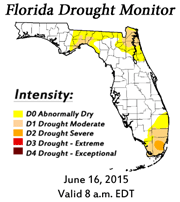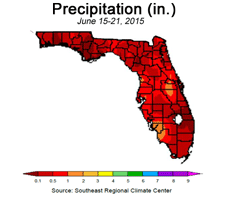Tropical Storm Erika Slams Hispaniola
Tropical Storm Erika is being adversely affected by high wind shears, dry Saharan air and the high mountains of Hispaniola. The storm continues to slide more westward than yesterday's forecasts indicated. There seems to be considerable talk about how well the storm will survive its journey over Hispaniola and Cuba - some think it might fall completely apart while others see it slowly reforming with 45-60 mph winds before landfall in S Florida. TS Erika's storm path and ntensity forecasts have been very difficult due to the complex mix of current weather patterns in place. At the very least, forecasters are predicting 4-8+ inches of rain for the eastern parts of the Florida peninsula. Floridians should review their severe weather plans now and prepare for windy and wet conditions affecting the state by as early as Sunday night.Be safe!
The AgEr team
__________________________
From WeatherUnderground...
Figure 2. Latest long-range radar image of Tropical Storm Erika from the San Juan, Puerto Rico radar.
Figure 3. Predicted rainfall for Erika for the 126-hour period ending at 8 am EDT September 2, 2015, from the 06Z (2 am EDT) Friday August 28, 2015 run of the HWRF model. This rainfall swath is likely displaced too far to the east, and will probably be centered directly over Florida. Rainfall amounts of 4 - 8" can be expected in many areas along Erika's path, with a few areas of 8+" (bright yellow colors.) Image credit: NOAA.
(From Dr. Jeff Masters - WeatherUnderground blog)...
Will Erika survive Hispaniola?
Erika's battle against dry air and high wind shear has caused the center of the storm to reform several times to the south of its original position, closer to the storm's heaviest thunderstorms. These southward shifts mean that Erika is now poised to track directly over mountainous Hispaniola island, whose highest peak exceeds 10,000 feet in height. This encounter will not go well for Erika, particularly since wind shear will remain a high 15 - 25 knots during the traverse, and dry air will continue to wrap into Erika's circulation during the crossing. These combined factors could lead to Erika's dissipation by Saturday morning. The traverse of the island may also cause the center to reform to the west of the island, which would then mean that Erika would encounter some of the high terrain of eastern Cuba. If Erika survives into Saturday morning, which I give a 50% chance of occurring, the storm may have time to intensify into a strong tropical storm with 60 mph winds before hitting South Florida. If Erika dissipates over Hispaniola Friday night, the storm could still reorganize into a minimal-strength tropical storm with 40 mph winds before encountering South Florida. The upper low over Cuba that is bringing high wind shear to Erika today is forecast to weaken on Sunday, which should cause wind shear to drop to the moderate range, 10 - 15 knots, which would allow some modest strengthening of Erika. A trough of low pressure will turn Erika to the north on Monday, and it is possible this turn will occur just west of the Florida, bringing Erika northwards along the west coast of Florida and into the Florida Panhandle by Tuesday--as suggested by the 00Z Friday (8 pm EDT Thursday) runs of the European and UKMET models. Regardless, much of Florida can expect heavy flooding rains from Erika Sunday through Tuesday.




